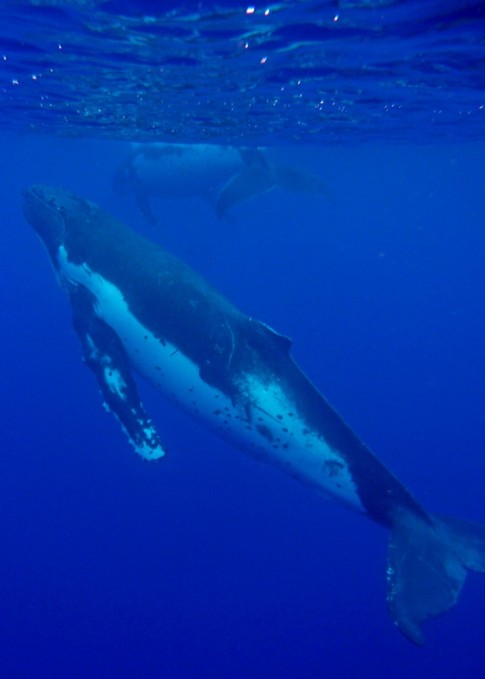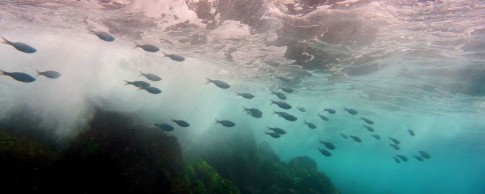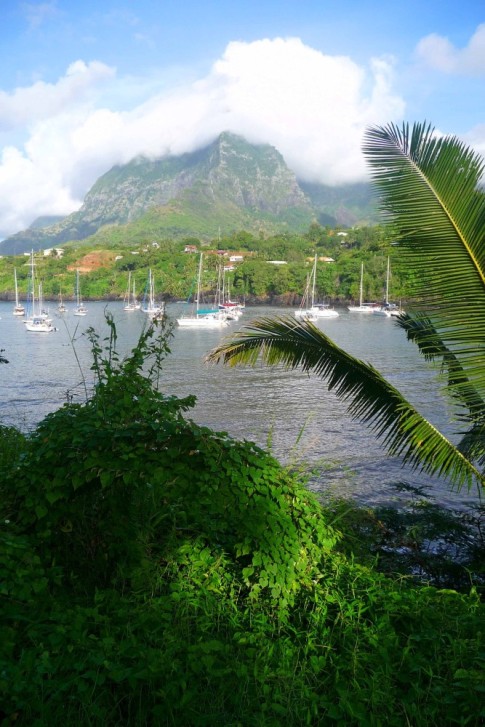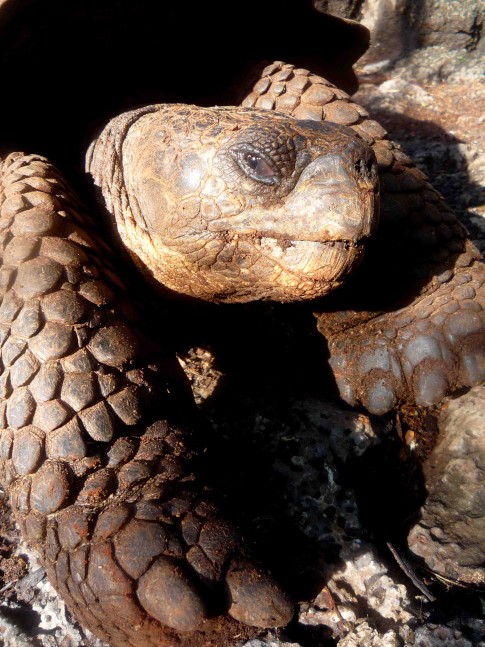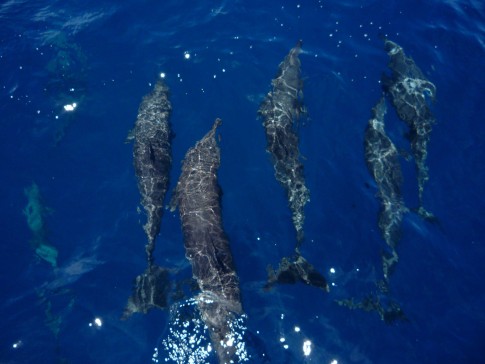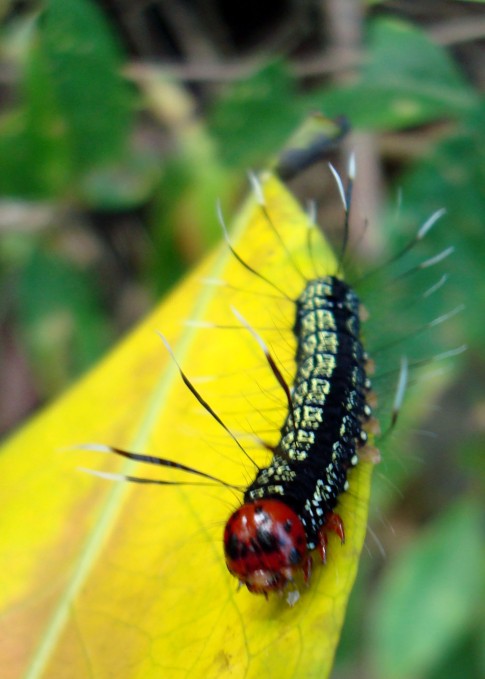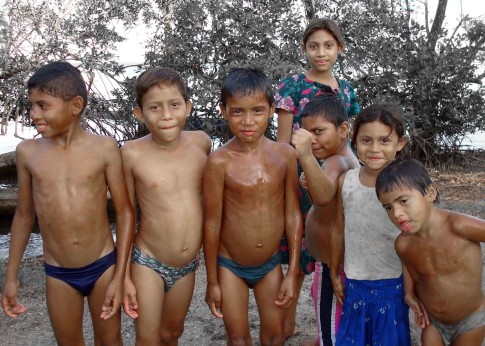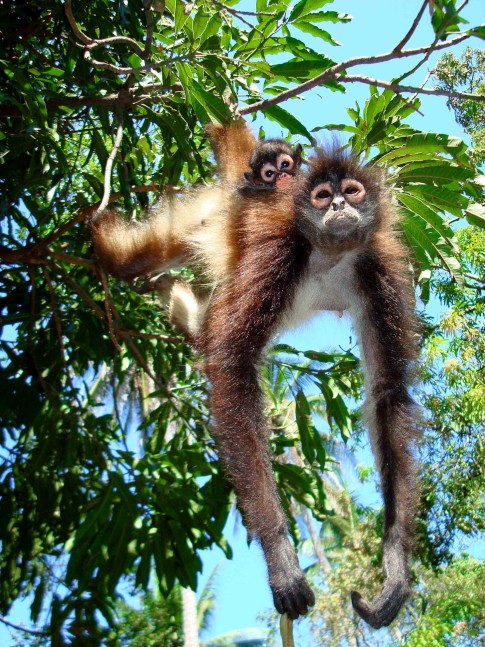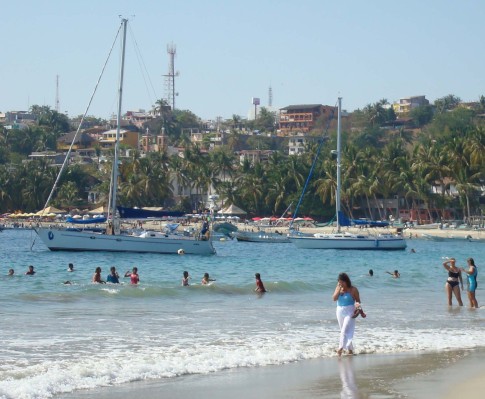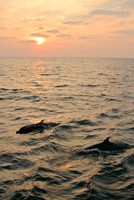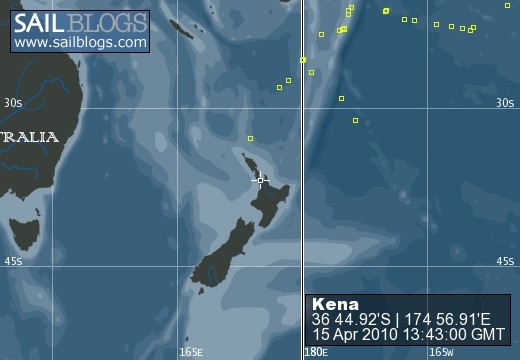
Kena
22 November 2009 | Tutukaka
11 November 2009
10 November 2009
09 November 2009
07 November 2009
07 November 2009
04 November 2009
03 November 2009
01 October 2009
29 September 2009
05 September 2009 | Nuku'alofa
27 August 2009
27 August 2009
23 August 2009
16 August 2009
14 August 2009
12 August 2009
09 August 2009
08 August 2009
08 August 2009
Day 6 - Ups and Downs
03 April 2009
Roger & Tane
Trip Log: 878 nautical miles.
Tane:
Today has already been quite an exciting day. Started with getting some hot coffee poured on my foot from a rogue cup that was flung by an unexpected wave. Pouring hot coffee on yourself does a far better job of getting you up and going than drinking it. After feeling sorry for myself for awhile Dad and I found some out-dated flares, so being a bit bored and having not a boat around for a few hundred miles, we decided to test them out. I naively assumed, not a connoisseur of guns, that being a small flare pistol it wouldn't have much of a kick. Of course Dad kindly declined to tell me that the flare, being a 25mm shell, was a good deal more powerful than a 12 gauge shotgun shell. It gave one hell of a bang and nearly ripped out my hands from the recoil. Needless to say it scared the living shit out me. Padre had a great giggle at that one. Next we had our first unscheduled man over board drill, though luckily it wasn't a man. We lost our reaching pole, an 8 foot long aluminum pole used to control certain sails, as the spinnaker sheet hooked around it and flung it over board. In a situation like that the first thing you do, person or part, is hit the man overboard button on the GPS to mark where it or they fell off. It's extremely important to do this because you can never go back to the same place by sight or direction, it's impossible in an endless horizon of rolling blue mountains. Next we had to get the spinnaker down. Not exactly easy to get down in a hurry, but we managed quite well, although the wind changed a bit and I nearly was taken off the side with it as it briefly filled again. After a bit of yelling and screaming we got it sorted and were back in line toward the floating pole. After a few passes of trying to get it by motoring past it was obvious it was a bit futile as it was getting pushed away by the waves generated from the bow of the boat. I decided the hell with it and went for a swim...I had secretly been wanting to for awhile. Well, as soon as I hit the water the first thing that popped into my head was that I am in 10,000+ feet of water and am probably on the smaller side of things lurking about. You do go down a few notches on the food chain wading around in the open ocean. Although, it's all a bit illogical to be frightened, it's pretty hard to tell yourself that during the situation. So I swam, terrifyingly fast, back to the boat dragging the pole behind me. The next challenge was to get back on the boat in large waves. It looks quite scary as the boat lifts out the water and comes crashing down, but if you wait and time it right it's relatively easy...and it was. Funny, that is the first time swimming since on the boat. After my little dip we got the strongest winds that we have had, and beginning to see walls of ominous clouds, perhaps time to get wet, again.
Roger:
The winds rose to 14 knots, gusting to as high as 20 for a while. This lasted until mid afternoon, when the wind suddenly died to the lowest levels we've seen in a long time --- less than 5 knots. After banging around in confused seas for a while, we started the engine. We have engine-driven refrigeration, so must start the engine at least once a day. Another reason for doing so is that, with the radar, computers, autopilot, and watermaker, the solar panels and wind generator can't keep up. I checked the bilge, only to discover a significant amount of a brown liqued sloshing around. It turned out to be diesel, and a quick inspection of the running engine showed a significant leak --- so significant that running the engine except in a short term emergency maneuver would not be possible.
We immediately went into low power and low water consumption mode. Without the engine, we will have to rely entirely on the solar panels and wind generator for power. We have been topping up the water tanks with the watermaker, not letting them get below half full. Making water takes about one amp hour per gallon, so to make water, we would have to conserve energy very carefully. Even if we didn't make water, we would need to hand steer most of the time --- although our autopilot is the most efficient available, it still takes too much power if we were to run it all of the time. And then there are the navigation lights at night, and the need to run the communications and navigation equipment, at least some of the time. Many cruising boats (although no catamarans) have self-steering wind vanes that require no power in addition to an autopilot. Most have auxiliary generators --- a second diesel engine driven one, or a small gasoline powered one --- to supply power without running the main engine. We don't have either of these devices. So... without the main engine, things change dramatically. We can still sail, of course, navigation is not a problem, the emergency beacons are battery powered, and we have a satellite phone. But without the main engine, the level of comfort drops significantly.
We determined that the leak was coming from a spot underneath the refrigeration compressor, so we took that off and ran the engine to determine that the problem was in a metal fitting for a pipe that takes fuel from the top of the engine mounted fuel filter to the injector pump. A quick check of the spares showed... no spare. There was, however, a spare of a similar pipe that takes fuel to the filter. What to do? We decided to take off the pipe for a closer look. After cleaning off paint and corrosion, we could see a crack at a joint. I happened to have a metal-reinforced epoxy paste in the spares, so we decided to try patching it with that. The alternative beyond that was to cut of the similar fitting from the spare and find some hose of the right diameter to join to the offending pipe, assuming the pressure requirements were not a problem. It was 10pm by the time we had done the epoxy repair, reinstalled the pipe, and had waited the requisite time for the expoxy to set. We've now been running the engine for several hours and the leak seems to have been fixed. This is one repair that will be watched very closely!
Tane:
Today has already been quite an exciting day. Started with getting some hot coffee poured on my foot from a rogue cup that was flung by an unexpected wave. Pouring hot coffee on yourself does a far better job of getting you up and going than drinking it. After feeling sorry for myself for awhile Dad and I found some out-dated flares, so being a bit bored and having not a boat around for a few hundred miles, we decided to test them out. I naively assumed, not a connoisseur of guns, that being a small flare pistol it wouldn't have much of a kick. Of course Dad kindly declined to tell me that the flare, being a 25mm shell, was a good deal more powerful than a 12 gauge shotgun shell. It gave one hell of a bang and nearly ripped out my hands from the recoil. Needless to say it scared the living shit out me. Padre had a great giggle at that one. Next we had our first unscheduled man over board drill, though luckily it wasn't a man. We lost our reaching pole, an 8 foot long aluminum pole used to control certain sails, as the spinnaker sheet hooked around it and flung it over board. In a situation like that the first thing you do, person or part, is hit the man overboard button on the GPS to mark where it or they fell off. It's extremely important to do this because you can never go back to the same place by sight or direction, it's impossible in an endless horizon of rolling blue mountains. Next we had to get the spinnaker down. Not exactly easy to get down in a hurry, but we managed quite well, although the wind changed a bit and I nearly was taken off the side with it as it briefly filled again. After a bit of yelling and screaming we got it sorted and were back in line toward the floating pole. After a few passes of trying to get it by motoring past it was obvious it was a bit futile as it was getting pushed away by the waves generated from the bow of the boat. I decided the hell with it and went for a swim...I had secretly been wanting to for awhile. Well, as soon as I hit the water the first thing that popped into my head was that I am in 10,000+ feet of water and am probably on the smaller side of things lurking about. You do go down a few notches on the food chain wading around in the open ocean. Although, it's all a bit illogical to be frightened, it's pretty hard to tell yourself that during the situation. So I swam, terrifyingly fast, back to the boat dragging the pole behind me. The next challenge was to get back on the boat in large waves. It looks quite scary as the boat lifts out the water and comes crashing down, but if you wait and time it right it's relatively easy...and it was. Funny, that is the first time swimming since on the boat. After my little dip we got the strongest winds that we have had, and beginning to see walls of ominous clouds, perhaps time to get wet, again.
Roger:
The winds rose to 14 knots, gusting to as high as 20 for a while. This lasted until mid afternoon, when the wind suddenly died to the lowest levels we've seen in a long time --- less than 5 knots. After banging around in confused seas for a while, we started the engine. We have engine-driven refrigeration, so must start the engine at least once a day. Another reason for doing so is that, with the radar, computers, autopilot, and watermaker, the solar panels and wind generator can't keep up. I checked the bilge, only to discover a significant amount of a brown liqued sloshing around. It turned out to be diesel, and a quick inspection of the running engine showed a significant leak --- so significant that running the engine except in a short term emergency maneuver would not be possible.
We immediately went into low power and low water consumption mode. Without the engine, we will have to rely entirely on the solar panels and wind generator for power. We have been topping up the water tanks with the watermaker, not letting them get below half full. Making water takes about one amp hour per gallon, so to make water, we would have to conserve energy very carefully. Even if we didn't make water, we would need to hand steer most of the time --- although our autopilot is the most efficient available, it still takes too much power if we were to run it all of the time. And then there are the navigation lights at night, and the need to run the communications and navigation equipment, at least some of the time. Many cruising boats (although no catamarans) have self-steering wind vanes that require no power in addition to an autopilot. Most have auxiliary generators --- a second diesel engine driven one, or a small gasoline powered one --- to supply power without running the main engine. We don't have either of these devices. So... without the main engine, things change dramatically. We can still sail, of course, navigation is not a problem, the emergency beacons are battery powered, and we have a satellite phone. But without the main engine, the level of comfort drops significantly.
We determined that the leak was coming from a spot underneath the refrigeration compressor, so we took that off and ran the engine to determine that the problem was in a metal fitting for a pipe that takes fuel from the top of the engine mounted fuel filter to the injector pump. A quick check of the spares showed... no spare. There was, however, a spare of a similar pipe that takes fuel to the filter. What to do? We decided to take off the pipe for a closer look. After cleaning off paint and corrosion, we could see a crack at a joint. I happened to have a metal-reinforced epoxy paste in the spares, so we decided to try patching it with that. The alternative beyond that was to cut of the similar fitting from the spare and find some hose of the right diameter to join to the offending pipe, assuming the pressure requirements were not a problem. It was 10pm by the time we had done the epoxy repair, reinstalled the pipe, and had waited the requisite time for the expoxy to set. We've now been running the engine for several hours and the leak seems to have been fixed. This is one repair that will be watched very closely!
Comments
| Vessel Name: | Kena |
| Vessel Make/Model: | Ganley Pacemaker 40 |
| Hailing Port: | Tutukaka, New Zealand |
| Crew: | Roger, Sally, Tane, Hunters all |
| About: | The Hunter family: Roger, originally from Tutukaka, New Zealand Sally, from Tasmania, Australia and Tane is from New Mexico. |
| Extra: | This leg of the trip is from Puerto Lucia, Ecuador to New Zealand. |
Kena's Photos - Main
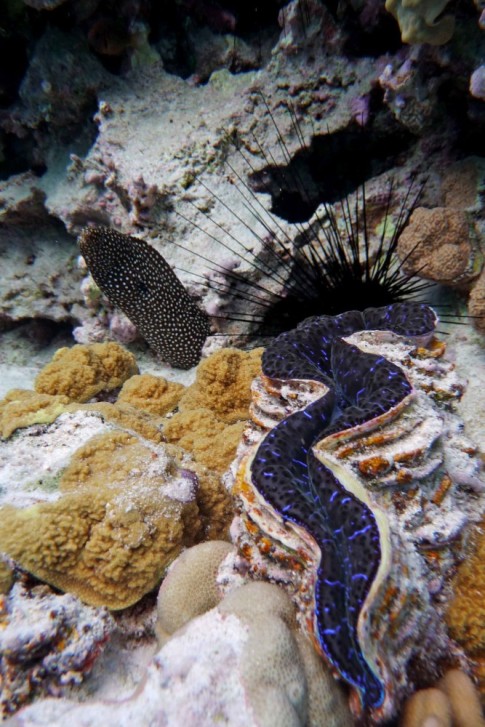 |
A few picks of Roratonga, where we picked up Tomas, and of the incredible Beveridge Reef
20 Photos
Created 1 September 2009
|
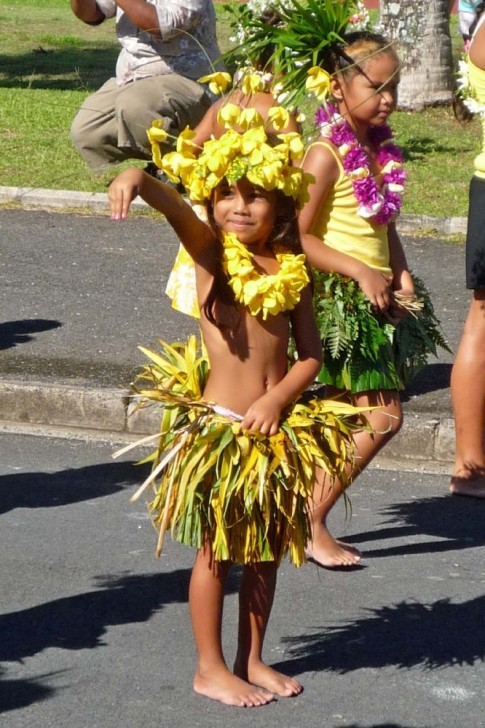 |
Our adventure in the islands of Tahaa and Raiatea in The Society Islands
18 Photos
Created 5 August 2009
|
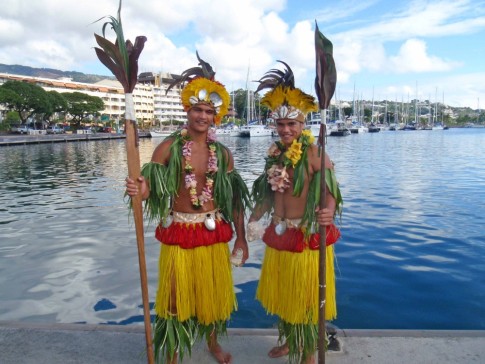 |
The Sailing Rendezvous in Tahiti and Moorea, plus a little of Huahine
35 Photos
Created 5 August 2009
|
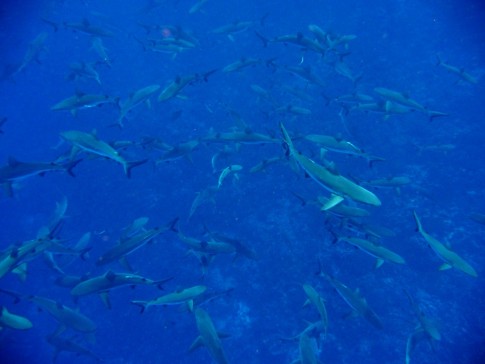 |
Our journey through the coral atolls of the Tuamotus in French Polynesia
65 Photos
Created 19 June 2009
|
S/V Kena
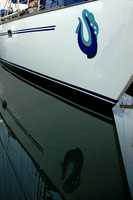
Who: Roger, Sally, Tane, Hunters all
Port: Tutukaka, New Zealand
